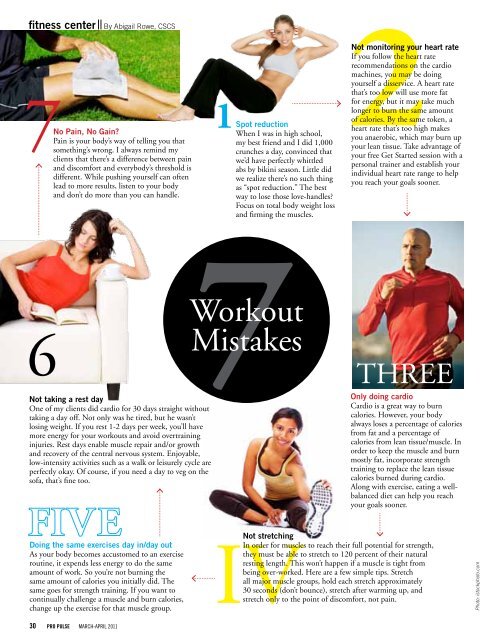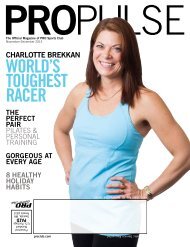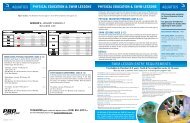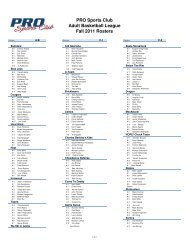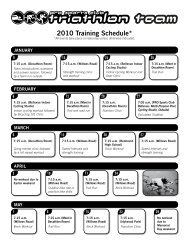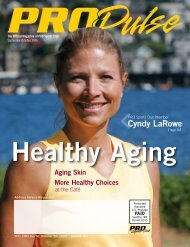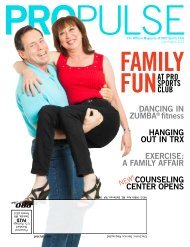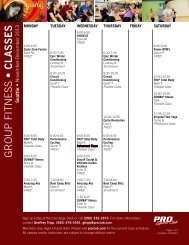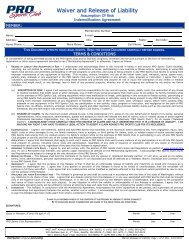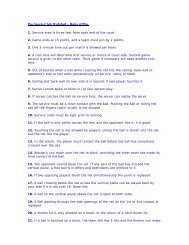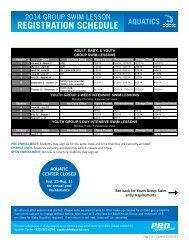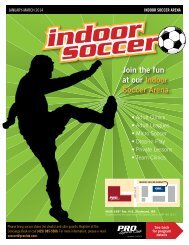online edition - PRO Sports Club
online edition - PRO Sports Club
online edition - PRO Sports Club
Create successful ePaper yourself
Turn your PDF publications into a flip-book with our unique Google optimized e-Paper software.
fitness center<br />
By Abigail Rowe, CSCS<br />
7No Pain, No Gain?<br />
Pain is your body’s way of telling you that<br />
something’s wrong. I always remind my<br />
clients that there’s a difference between pain<br />
and discomfort and everybody’s threshold is<br />
different. While pushing yourself can often<br />
lead to more results, listen to your body<br />
and don’t do more than you can handle.<br />
1Spot reduction<br />
When I was in high school,<br />
my best friend and I did 1,000<br />
crunches a day, convinced that<br />
we’d have perfectly whittled<br />
abs by bikini season. Little did<br />
we realize there’s no such thing<br />
as “spot reduction.” The best<br />
way to lose those love-handles?<br />
Focus on total body weight loss<br />
and firming the muscles.<br />
Not monitoring your heart rate<br />
If you follow the heart rate<br />
recommendations on the cardio<br />
machines, you may be doing<br />
yourself a disservice. A heart rate<br />
that’s too low will use more fat<br />
for energy, but it may take much<br />
longer to burn the same amount<br />
of calories. By the same token, a<br />
heart rate that’s too high makes<br />
you anaerobic, which may burn up<br />
your lean tissue. Take advantage of<br />
your free Get Started session with a<br />
personal trainer and establish your<br />
individual heart rate range to help<br />
you reach your goals sooner.<br />
6<br />
Not taking a rest day<br />
One of my clients did cardio for 30 days straight without<br />
taking a day off. Not only was he tired, but he wasn’t<br />
losing weight. If you rest 1-2 days per week, you’ll have<br />
more energy for your workouts and avoid overtraining<br />
injuries. Rest days enable muscle repair and/or growth<br />
and recovery of the central nervous system. Enjoyable,<br />
low-intensity activities such as a walk or leisurely cycle are<br />
perfectly okay. Of course, if you need a day to veg on the<br />
sofa, that’s fine too.<br />
Workout<br />
Mistakes<br />
THREE<br />
Only doing cardio<br />
Cardio is a great way to burn<br />
calories. However, your body<br />
always loses a percentage of calories<br />
from fat and a percentage of<br />
calories from lean tissue/muscle. In<br />
order to keep the muscle and burn<br />
mostly fat, incorporate strength<br />
training to replace the lean tissue<br />
calories burned during cardio.<br />
Along with exercise, eating a wellbalanced<br />
diet can help you reach<br />
your goals sooner.<br />
Doing the same exercises day in/day out<br />
As your body becomes accustomed to an exercise<br />
routine, it expends less energy to do the same<br />
amount of work. So you’re not burning the<br />
same amount of calories you initially did. The<br />
same goes for strength training. If you want to<br />
continually challenge a muscle and burn calories,<br />
change up the exercise for that muscle group.<br />
IV<br />
Not stretching<br />
In order for muscles to reach their full potential for strength,<br />
they must be able to stretch to 120 percent of their natural<br />
resting length. This won’t happen if a muscle is tight from<br />
being over-worked. Here are a few simple tips. Stretch<br />
all major muscle groups, hold each stretch approximately<br />
30 seconds (don’t bounce), stretch after warming up, and<br />
stretch only to the point of discomfort, not pain.<br />
Photo: istockphoto.com<br />
30 <strong>PRO</strong> PULSE MARCH-APRIL 2011


